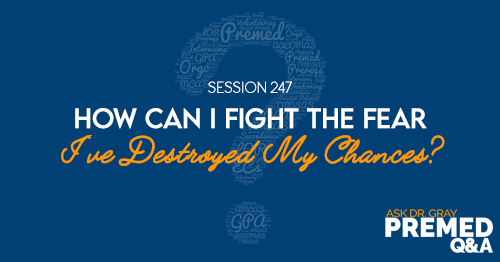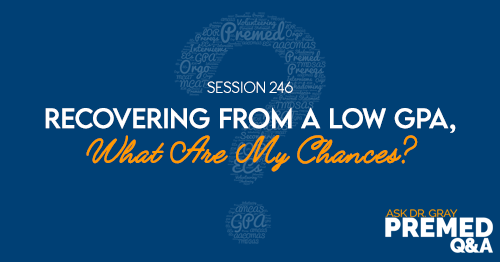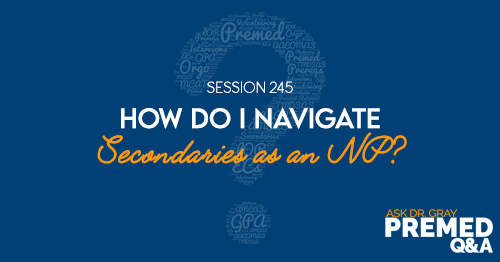Apple Podcasts | Google Podcasts
Session 248
This apprehensive student is seeking advice on various aspects of the medical school application process such as grades, clinical experience, MCAT preparation, application timelines, and evaluating extracurricular activities. Let’s help her develop a pragmatic plan to strengthen their medical school application
Ask Dr. Gray: Premed Q&A is brought to you by Blueprint MCAT. Listen to this podcast episode with the player above, or keep reading for the highlights and takeaway points.
The episodes in this podcast are recordings of our Facebook Live that we do at 3 pm Eastern on most weekdays. Check out our Facebook page and like the page to be notified. Also, listen to our other podcasts on MedEd Media. If you have any questions, call me at 617-410-6747.
Question of the Day:
Q: “How would my grades as well as me transferring twice affects my application?”
A: Transferring schools by itself usually does not significantly affect applications, but grades are very important. As long as you show improving grades over time, past school transfers should not be a major issue.
Retaking Chemistry Courses After Earning Cs
The student asks if they should retake general chemistry and organic chemistry courses where they earned Cs. She says she had seen advice that medical schools don’t like to see Cs in chemistry courses.
Technically, she does not have to retake the courses, but some medical schools may see the Cs negatively. However, as long as you’re able to show strong academic ability in other courses, retaking the chemistry courses is not necessarily required from a mathematical standpoint of grade calculations.
It could potentially show improvement, but there is also a risk of doing poorly again. Rather, focus on taking other advanced science courses to demonstrate their academic capacity.
“From a math standpoint, there’s no difference in retaking the courses versus just taking other upper division courses to show academic ability.”
Defining Clinical Experience Hours
The student finds it difficult when receiving conflicting information from different people about what counts as clinical experience. She wants to ensure she is pursuing the right activities. The student worked as a patient transporter but many people told her it did not count as clinical hours. However, the student felt it was clinical since she worked hands-on with patients, moving them and assisting nurses. This contradicted what others had said.
One of the more frustrating things the advisor discussed was getting inconsistent advice from different people about the medical school application process.
If you asked 100 different people for guidance, you would likely receive 100 different responses. This makes it difficult for applicants to determine the “right” path when information varies widely. What students should do is to ask a few trusted sources. Then synthesizing multiple perspectives, rather than relying on any single opinion. That way, they can make the best-informed decisions amid conflicting advice from numerous individuals.
“Stop asking everyone everything. Ask a few trusted people, and just try to put together as much information as possible to make the best decision for you.”
The Value of Enjoyable Clinical Activities
While some medical schools may not consider patient transport clinical experience, it should not deter you from continuing in that role if you find it enjoyable and compatible with your schedule.
There are many medical schools, so one school’s perspective does not preclude an activity from benefiting your overall application. Pursuing experiences you genuinely like was deemed more important than worrying about any single school’s preferences.
Beyond Surface-Level Definitions: Finding Meaningful Clinical Experiences
There are examples of jobs that would likely not be considered strong clinical experiences, such as being a janitor in a hospital or working the front desk at a clinic. While some aspects of these roles may take place in a medical setting, they would not provide direct patient interaction or involvement in clinical care.
Stop comparing yourself with others and overanalyzing differing opinions, as this process rarely has strictly defined “right” answers.
Given the complex nature of medical school admissions and variety in applicants, there is often no single clearly superior path. The best approach is focusing inward on gaining rich experiences rather than worrying excessively about outside perspectives that may conflict or be ill-suited to one’s individual circumstances.
The key is doing one’s best with the opportunities available while pursuing their own interests and strengths.
Beyond Content Review: Mastering the MCAT Through Consistent Practice
The student asks for advice on studying for the MCAT. What I recommend students do is practicing a large number of practice questions and full-length timed exams. Simply reading the content books is not sufficient preparation. It is important to understand how the test and questions are structured in order to perform well.
Also, try to find a study group of 3-4 peers who can quiz each other on different subject areas as another effective preparation strategy.
Practice Tests vs. Passive Content Review
While content review is necessary, it is not enough on its own to prepare for the unique challenge of the actual exam. Students commonly make the mistake of thinking they are ready after just reading the books. However, the MCAT tests more than just recall of facts – it evaluates how well an applicant can analyze passages and questions under time pressure.
To truly prepare, focus on practice over passive content review. This includes working through thousands of practice questions from question banks and full-length exams to gain experience with the question formats and logical reasoning skills required.
Reviewing Both Right and Wrong Answers
It is also important to review practice work, both right and wrong answers, to understand why responses were correct or incorrect. This feedback helps students identify weaknesses. Studying with a group allows peers to quiz each other on different subject areas and support each other through full-length practice exams, further enhancing preparation.
Consistent practice emulating the actual test conditions is key to building the skills and endurance needed for test day.
Building Shadowing Experiences Over Time
The student asked about her current status with shadowing experiences, as she felt like she did not have very many hours accumulated yet.
Shadowing as an important part of demonstrating exposure to the medical field. However, do not to be too hard on yourself as gaining shadowing opportunities takes time. Try to focus on consistently pursuing new opportunities. In her case, that’s the the hospital volunteering she recently started. With continued effort building experiences over the long term, your application can strengthen even if progress feels slow at the moment.
What Counts as Clinical Experience
“Clinical experience is where you are interacting with patients.”
Clinical experience involves directly interacting with and caring for patients. To qualify, one typically needs to be “close enough to smell the patient,” meaning physically close to them while providing some element of their care.
Patient sitting is an example of a clinical role since it involves ensuring patient safety and responding to needs, even if just by preventing falls. Front desk or registration jobs in a medical setting, however, do not qualify as they lack direct patient contact and care responsibilities. Ultimately, using judgment about what roles meaningfully involve assisting patients is important in categorizing activities as clinical or not.
Rethinking Where Clinical Experience Counts
As our conversation delved into defining clinical experience, one perspective I addressed was the misconception that such activities only qualify if performed within the walls of a traditional medical setting like a hospital or clinic. While many strong opportunities naturally arise in these environments, I wanted to dispel the notion that location alone determines an experience’s clinical merit.
A case in point I provided was hospice work, which frequently involves direct patient care in their homes rather than a facility. Despite taking place outside of a clinical setting, hospice offers profoundly meaningful interactions that give invaluable insights into healthcare. Being with patients in their final stages, providing physical and emotional support – these are experiences that deeply shape one’s understanding of medicine.
At the end of the day, we must consider experience quality and nature of roles above all else when evaluating clinical value. Where care is delivered matters far less than how one applies their skills, knowledge and compassion to alleviate suffering. While medical centers present plentiful prospects, we should recognize the clinical riches that also emerge in nontraditional settings through meaningful engagement with those in need.
Choosing Your Words Wisely
As we talked through various extracurricular pursuits, one piece of advice I offered was to exercise care with one particular word – “volunteer.” While volunteering can be a meaningful way to spend time, I find applicants sometimes lack specificity when describing such roles.
Merely labeling an activity as volunteering doesn’t fully illustrate whether it was clinical or non-clinical in nature. The devil is in the details, and admissions committees need clarity on an experience’s medical relevance or lack thereof. Rather than making assumptions, they require unambiguous language.
That’s why I suggested opting for descriptors like “clinical volunteering” versus “non-clinical volunteering” wherever possible. These terms leave no room for misinterpretation about the presence or absence of direct patient interaction. Especially for borderline experiences, precise phrasing paints the clearest picture.
In the end, choosing your words wisely helps ensure your experiences are understood as you intend. With the right terminology, there’s no question as to the medical significance conveyed by your extracurricular commitments.
“Be careful with the word volunteer, because volunteer can be clinical or non clinical. And so the better language to use is just clinical or non clinical.”
Navigating Changes in Experience
As our discussion covered the evolution of clinical experiences, one transition the student described was taking on a summer research opportunity that prevented returning to their prior patient transport role once complete. While she enjoyed gaining exposure to this new area of work, real-world constraints like the transport position already being filled required exploring alternatives.
Her next position in medication consultation held interest too. However, balancing such commitments with academic duties proved challenging as midterms approached. Faced with making a choice, prioritizing grades emerged as the wisest decision to reinforce foundations for medical school.
We all encounter unexpected changes that disrupt well-laid plans at times. Therefore, we should be able to handle them gracefully through open-mindedness to new paths. Though adjustments feel daunting, each stage still cultivates valuable soft skills and perspectives that enrich one’s journey in healthcare. More than any single experience, demonstrating a long-term commitment to learning serves applicants well through resilience during inevitable transitions.
Prioritizing Grades While Pursuing Meaningful Clinical Experiences
Grades must be the top priority above all else. Clinical experiences are also important, but come secondary to academic performance. Hospice is a great option for clinical hours due to its flexibility – the student can schedule shifts around their class schedule.
Additionally, jobs like scribe, EMT, and medical assistant are “big” clinical opportunities. And that’s because hands-on experience are provided, though certification and training requirements would need to be taken into account. Ultimately, focus on pursuing clinical roles that can accommodate an academic-first mindset to balance responsibilities.
The Burden of Perceived Perfection
A recurring theme I’ve observed in advising pre-med students is the immense pressure they place upon themselves to achieve flawless applications. There seems to be a pervasive mindset that any shortcoming or misstep could doom one’s chances at medical school acceptance.
While competition is understandably high, this all-or-nothing mentality breeds unnecessary stress and self-doubt. Students feel they must satisfy unrealistic standards of having a perfect GPA, MCAT score, activity list and narrative to be considered at all.
“There’s just no perfect path. It’s where are you right now? Where do you want to go? Let’s figure it out.”
But the truth is admissions are highly subjective, evaluating the whole person beyond numbers on a page. Committees seek well-rounded candidates who exhibit growth and dedication over time. No applicant possesses every ideal quality, nor does one blemish ruin their shot.
Rather than obsess over an impossible ideal of perfection, it’s better to stay focused on steady improvement. Small wins matter much more than momentary setbacks. Having compassion for oneself and perspective on life’s ebbs and flows are also traits that serve applicants well on their journey.
“Where are you at right now is not a prediction of your potential. It’s just a snapshot of what you’ve done so far.”
The pressure to achieve flawlessness is largely self-imposed. While competition exists, remembering our shared humanity can alleviate undue stress over minor imperfections in a works-in-progress application.
Beyond the Pages: Preparing Effectively for the MCAT
As an advisor, one misconception I frequently encounter is the idea that simply consuming content is sufficient MCAT preparation. While knowledge is necessary, it is far from the whole story when it comes to acing this multi-faceted exam.
Reading Does Not Equate to Readiness
All too often, students assume reading textbooks front to back equates to readiness. But the MCAT differs significantly from an ordinary test of memorization. It probes how well one can analyze complex passages, think critically under pressure, and apply logic to multi-step problems.
“The the biggest mistake students make is just reading the books and going: ‘Okay, I’ve read them all I’m ready for the test.’ No, you’re not”
Merely absorbing information does little to build these crucial skills. One must practice actively emulating the test-day experience through full-length practice exams and dedicated question banks. Only then do the subtleties of MCAT question styles and pacing become second nature.
Reviewing Appropriately is Key
Reviewing practice work, both right and wrong answers, provides invaluable feedback to identify weaknesses. It is through this iterative process of self-assessment that mastery truly takes shape.
While content comprehension lays groundwork, the real exam preparation lies beyond the pages in consistent, targeted practice. Those who grasp this distinction set themselves up for MCAT success through comprehensive training rather than passive review alone.
Navigating the Medical School Application Journey
The medical school application process presents a daunting set of tasks for even the most organized student. From crafting compelling essays to tracking deadlines and assembling strong letter packets, the list of responsibilities seems endless. It’s no wonder this period causes many pre-meds undue stress and anxiety.
Enter Application Academy, a program designed to guide applicants every step of the way. Rather than floundering alone, students gain access to an entire community of peers and advisors for support. Interactive webinars demystify complex topics like activities lists and interview preparation. One-on-one advising stands ready to answer individual concerns.
Perhaps most valuable is the structured curriculum that breaks the application into manageable modules. Students can check off requirements at their own pace while staying on schedule. This framework eliminates the paralysis that comes from facing such an enormous undertaking.
For those embarking on the application season, Application Academy offers peace of mind. No longer an isolating experience, the process becomes a collaborative journey with constant guidance. While the work remains, this program ensures applicants have every resource for navigating it smoothly.
Finding Value Beyond the Application
When evaluating extracurricular commitments, one’s motivations matter greatly according to the advisor. A common misstep is joining groups solely with the application in mind, rather than personal enrichment. But networking presents a worthwhile exception. Making connections can open meaningful doors whether or not experiences end up on one’s CV. Interacting with others opens our perspectives in ways no transcript can convey.
“If you’re doing it because you think it benefits you in terms of networking and connections, that’s the perfect reason to do it. If you’re doing it only because you think it’s going to help your application, that’s the wrong reason to do it.”
Pursuing opportunities primarily for relationship-building potential as perfectly valid. After all, medicine is a people-centered profession where we rely on each other. Cultivating a web of advisors enhances one’s learning and career trajectory.
While checking boxes holds some value, finding intrinsic reasons for involvement nourishes well-rounded growth. Applications come and go, yet contacts may endure for life. Prioritizing networking recognizes this by focusing outward on community.
So if an activity sparks conversations advancing one’s goals and understanding, such fruitful socializing deserves celebration – not criticism. Applications only tell part of our story, and relationships often prove most rewarding.
Rethinking Medical School Acceptance Rates
As premed students, we’re constantly bombarded with statistics touting the competitiveness of gaining admission to medical school. Figures like acceptance rates under 10% are routinely cited, fueling anxiety over our chances of success. However, the true acceptance rate is closer to 60% once unnecessary context is removed. This reframing provides a much-needed dose of reassurance.
Upon closer examination, schools’ published rates only reflect a single application cycle and service. But many applicants apply broadly through multiple avenues, increasing their likelihood of acceptance somewhere.
Some applications represent candidates who simply aren’t ready, skewing the numbers downward. Excluding these from consideration paints a truer picture of qualified applicants’ odds.
Rather than fixating on intimidating stats, focus inward on continual growth. With hard work and guidance navigating the complex process, achieving one’s medical dreams remains very achievable for the dedicated. An inflated 60% acceptance benchmark reminds us of this within reach potential.
Links:
Medical School HQ Facebook page
Medical School HQ YouTube channel
Instagram @MedicalSchoolHQ
Join the Application Academy!
The Premed Playbook: Guide to the Medical School Personal Statement
The Premed Playbook: Guide to the Medical School Application Process
SEARCH SITE
LISTEN FOR FREE












